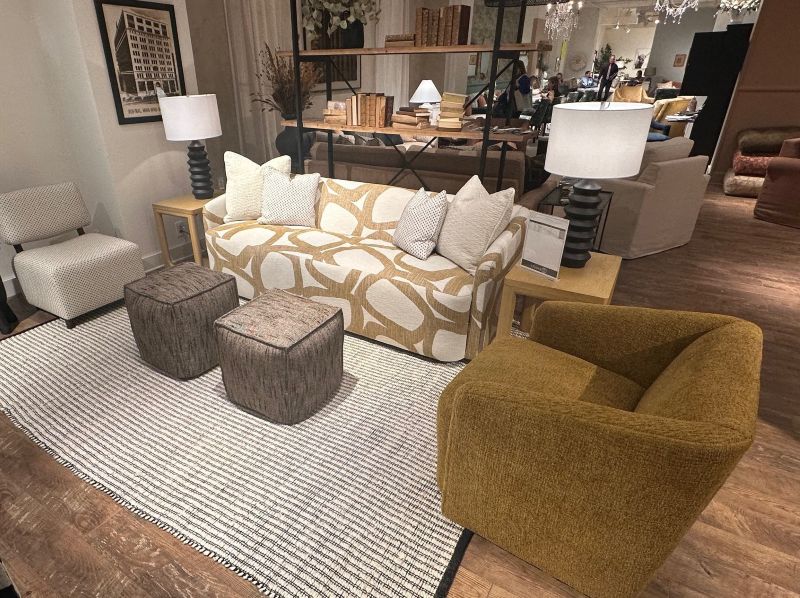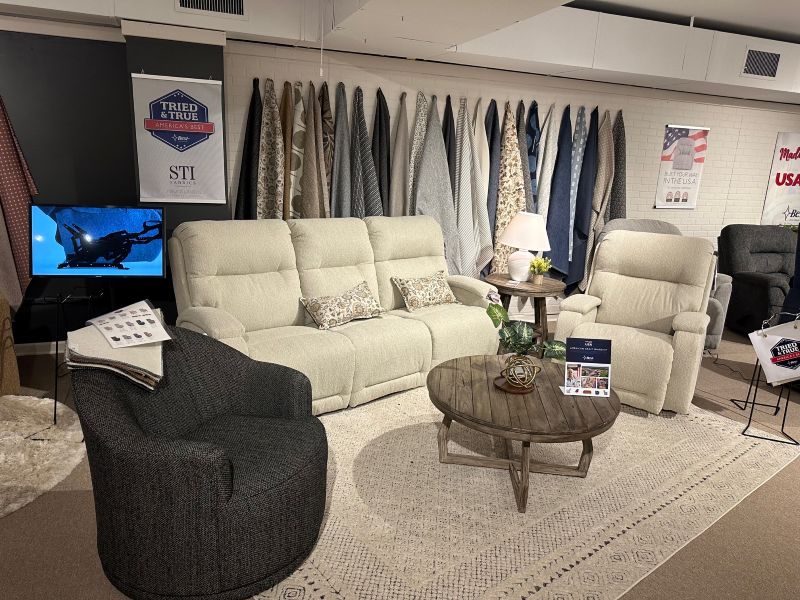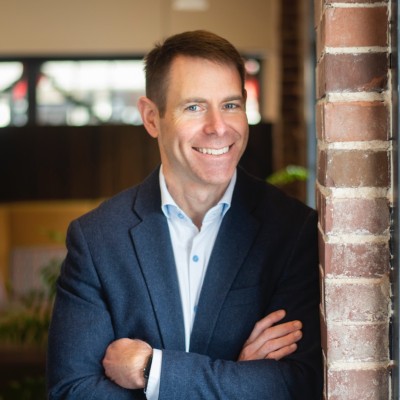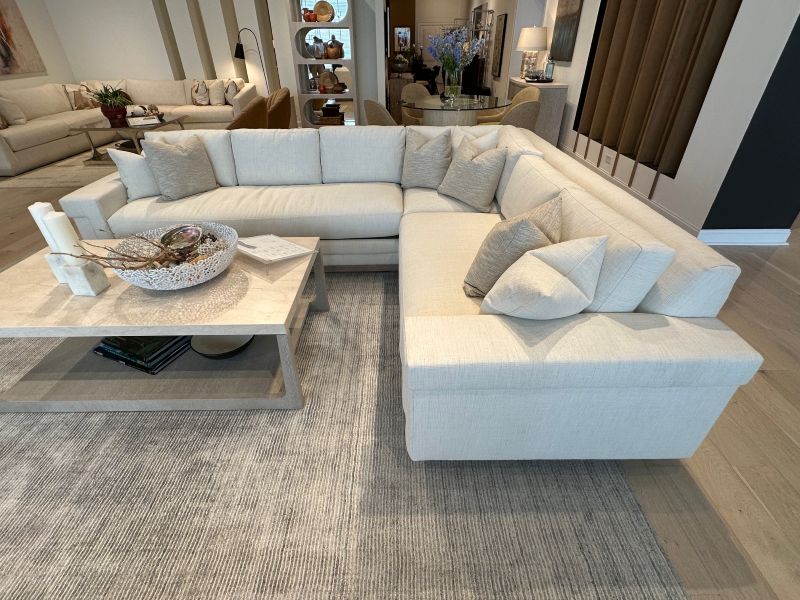Companies recover pieces, using domestic fabrics while also pulling from inventory to help offset the higher prices of fabrics from Chinese mills facing 145% tariffs
HIGH POINT — Domestic stationary upholstery manufacturers were among the most popular resources at market, particularly given their perceived value in the realm of tariffs on imported goods.
They also are valued because of their speed to market compared with Asian imports, meaning dealers and designers alike can get the products within several weeks, which is about the time it takes to flow goods on the water from Asia not including production times.
Yet imported fabrics and leathers, a major materials cost that just more than doubled with Chinese covers, gave some buyers pause given how important they are to the mix. Despite the perceived high quality of China-made fabrics, a 145% tariff on these materials simply put them out of the market for just about every customer, retailers and designers alike.
At market, this required domestic upholstery resources to do a 180-degree turn, by offering alternatives from Turkey, Belgium, Italy and the U.S. For many, this worked to their advantage, showcasing their ability to meet the customer demand in a way that is similar to how they handle custom orders.

“I think it drove a lot of sales,” said Alex Shuford III, chief executive officer of RHF Investments, which owns Century, Hickory Chair, Hancock & Moore, Highland House, Cabot Wrenn and Pearson, all major high-end upholstery manufacturers. “People were coming in and swapping out floor samples and trying to condition their floors for what might be three to six months of turbulence. They wanted to have a secure, non-Chinese and, even more importantly, a domestic cover story.”
“There was also a lot of talk about the fabric grades and leathers that will be changing because of the tariffs,” he added. “A lot of that is happening right now on the fabrics that are the starting price point, so guys like Valdese Weavers and STI were Johnny on the spot that showed up with alternative covers made in America with American yarns that replaced some of that. … For the most part, we found that our domestic mills were able to step in with alternatives, or the mills that were producing in China are looking at partnerships in Vietnam and India to move things.”
Overall, he estimated that across all RHF brands that about 10% of its fabrics and roughly 15% to 17% of its leathers are of Chinese origin.
Some will be discontinued while some others will be moved to another country, while others will be shifted to a higher grade, allowing the consumer to decide whether the upholstery is still a value with those materials.
“If it used to be a grade 18 and it is now a grade 28 and you still love it, you can pay the difference and get what you want,” he said, adding that the company is shifting to leather alternatives in Italy and South America.
“We do lean on those tanneries that are providing for that new domestic Chinese upholstery industry for raw hides and tanned hides,” he said of the leather product coming from China. “So that shift is actually going to take a little more time, but it will favor Europe and it will favor South America. There is not a lot of that in the U.S. anymore as tanning is a tough business. You don’t want that in your neighborhood. They are the jobs we may not want coming back to the U.S., so we will be shopping a lot more heavily in Europe and we will be shopping the South American tanneries more heavily.”
Tim Newlin, president and chief executive officer of upholstery manufacturer Norwalk Furniture, estimated that about 60% of its fabrics are imported and 40% are domestic. In addition to countries like Turkey, India and Vietnam, the imported mix also includes some fabrics from China, he noted.

“And a lot of those with the 10% tariff didn’t get enough of an increase to move them from one grade to another,” he said. “Some did, but maybe they were at the top edge of a grade and it bumped them up a grade, but the China fabrics are the problematic ones because some of those are going up four grades. They are basically doubling in price per yard. So they have got to move.”
Retailers, he noted, also have the choice whether to keep the fabric and charge a higher price on the sofa, chair or sectional, for example. Or they can recover it with a fabric from the wall that is similar in quality and pattern or colorway and keep it the same price.
Thus, that ability to change out fabrics aligns directly with Norwalk’s capability as a custom upholstery manufacturer. He noted that this capability produced a lot of strong recover orders at market on new products.
“When you are custom, you are not stuck,” he said. “You still have options to keep your price the same if you want to.”
He noted that while some customers stuck with China fabrics, believing that the number will fall well below 145%, he said the tariff situation also drove interest in U.S.-made fabrics. Even if the China-tariffs don’t fall dramatically, the company still will have the ability to recover products in fabrics from the U.S. or other lower-tariff countries.

“When they got here, they knew the deal, and they made their choices and we didn’t really talk much about it,” he said of conversations with customers regarding tariffs.
“We don’t like where all this stuff is going and causing turmoil, but I am not concerned. We can just keep running with our game plan,” he said, noting that the company opened a lot of new accounts at market. “Which is a good healthy sign. That is the lifeblood of your next year.”
These and other manufacturers had displays of American-made fabrics in their showrooms. This included Best Home Furnishings, which also touted its capabilities with a broad mix of product, from recliners and accent seating to sofas and sectionals, to name several core categories.

While the company’s product introductions were a little lighter than normal given last season’s launch of the licensed Field & Stream line, it had nearly 100 fabrics on display, including a high percentage of U.S. fabrics that included about 20 late additions from STI/Revolution.

“With the whole tariff situation, we were focused and tried to create a lineup that was special with American-made products and American-made fabrics,” said Eric Vollmer, senior marketing strategist, noting that American-made products are priced competitively with China-made products. “It is just so you have consistency and you know what the price is going to be. It is not going to fluctuate in two or three weeks or even six months for the most part. That’s been a really positive message we are pushing and that retailers like hearing.”
Other fabrics in its mix are from India, Turkey and China, Vollmer said, adding that the company also has about 40-50 leathers from South America, Italy and China that it cuts and sews in its Indiana facilities.
He added that retail reception to the U.S.-made materials has been strong and that attendance was strong, up about 10% by late Saturday afternoon.
Strong inventory positions also are helping some of these companies, as they provide tariff-free materials that are also available to be applied quickly to new orders.
“We as a company are just on hold and are not raising prices on anything,” said Robert Yount, president of Artistica Home, of the company’s domestic line produced in Hildebran and Lexington, North Carolina. We are just trying to support our customers and are in a very advantageous inventory position and that helps us a lot.”

He said that despite some concerns regarding attendance heading into market, and some overall perceived negativity and slowdown related to tariffs, “We are not really seeing it. We are writing orders.”
And while tariffs on China and other parts of the world do have manufacturers at the middle to upper-end segment of the upholstery industry in a holding pattern, people are still on the lookout for other options.
“We are all just trying to figure out what we can go forward with and what we can get from American mills,” Yount said, noting that while it has some China fabrics in stock, it also has held up orders for new fabrics from China. The company also has alternatives that are sourced in India, Turkey and the U.S.
RW Collective, which recently purchased upholstery manufacturer Bauhaus Furniture, said that it has a strong inventory of fabrics that helps it avoid tariffs, including those on China products. But for items it did not have in stock, it also recovered certain products to make sure they were tariff-free heading into market.

“The biggest challenge was fabric and we jumped on that immediately, so we are in a good position,” said Rebekah Osborn, chief operating officer. “We have a really strong fabric inventory supply right now and there are some key fabrics we don’t have in stock that are on their way, so they beat the big tariff increase. … And any fabric supplier that has U.S. fabric inventory we are trying to buy up as much as we can. We expect that the U.S. and China are going to make a deal and that this is going to dissipate over the next few week or months, but until that happens, we have got to be prepared for it and we really don’t want to raise prices.”
The company also pulled a dozen or so products that were not in stock heading into market to avoid any pricing uncertainties.

“They were new introductions that we just pulled back off the floor because we knew we didn’t even want to try to figure out what pricing might be on it,” added Michael Carey, chief executive officer, noting that the company will revisit those pieces when the tariff picture becomes more clear.
The company also had another 150 new furniture items it was showing at market, roughly half of which is domestic upholstery, including pieces that already were in production when it acquired Bauhaus.
“It’s not like we didn’t have another 150 items,” he quipped.
As a domestic manufacturer, Albany Industries also has the ability to pivot quickly, largely because of its supply chain, which includes its own cut-and-sew facilities in Mexico and Vietnam that ship kits to its six domestic upholstery production facilities. While a country such as Mexico is higher in labor costs than Asia, it is also closer to the U.S. market and thus can produce and ship kits of its most popular fabrics, while also pivoting to produce kits that meet specific configurations as the demand arises.

“It is a huge advantage in our opinion, and the reason we did this was not because of tariffs,” said Craig Zielinski, president. “Any manufacturing facility is going to have a limited finite capacity, but I want to be late point convert. The one thing we can never predict — and I have been in other industries and they can’t predict it either — and that is what the customer is going to buy. As an operations guy, I always want to forecast and I would love to have 100% forecast accuracy, but I don’t believe it exists in any industry and it sure doesn’t exist in this one.
“So what we do is say ‘how do we make the most flexible supply chain that services the customer as best as possible’ and that is what we have tried to do,” he added.
Still, the industry continues to grapple with the shift of products from China to other parts of the world, and what it will mean for consumers that have gotten used to the type of quality produced in China. It’s an issue that will be front and center at the upcoming Interwoven show May 20-22 in High Point.
For some, the shift out of China could have even further-reaching implications as it will take some time for other countries to achieve similar quality and value.
“Can the American mills still create the same weight of fabric and the same quality of yarn at a similar price point to achieve the same value proposition?” asked Shuford, of RHF Investments, while also referring to the cost differences between the U.S. and China. “They are working at it. It’s a struggle. We have a higher labor base here and there is still labor in textile weaving. But we still think it’s an opportunity for those American textile mills right now and frankly also the mills in Turkey and India and Vietnam. The spotlight is also on China. They need to get to a deal pretty quickly or they are going to lose an entire segment of their textile base. Somewhat permanently.”



